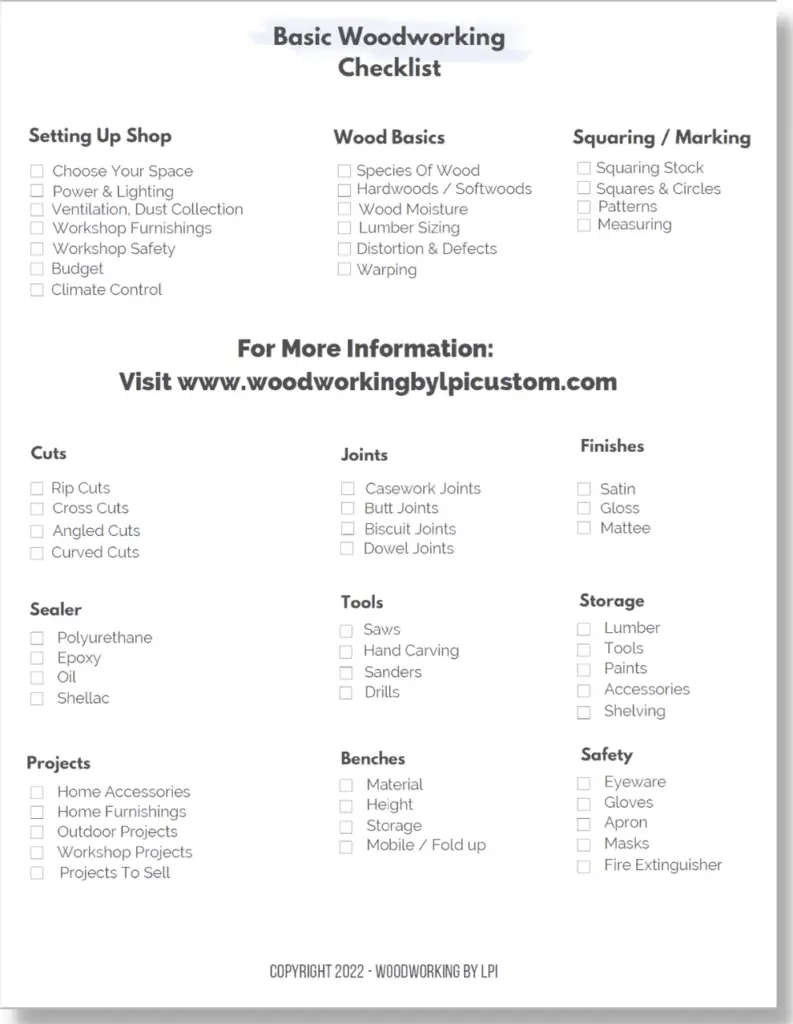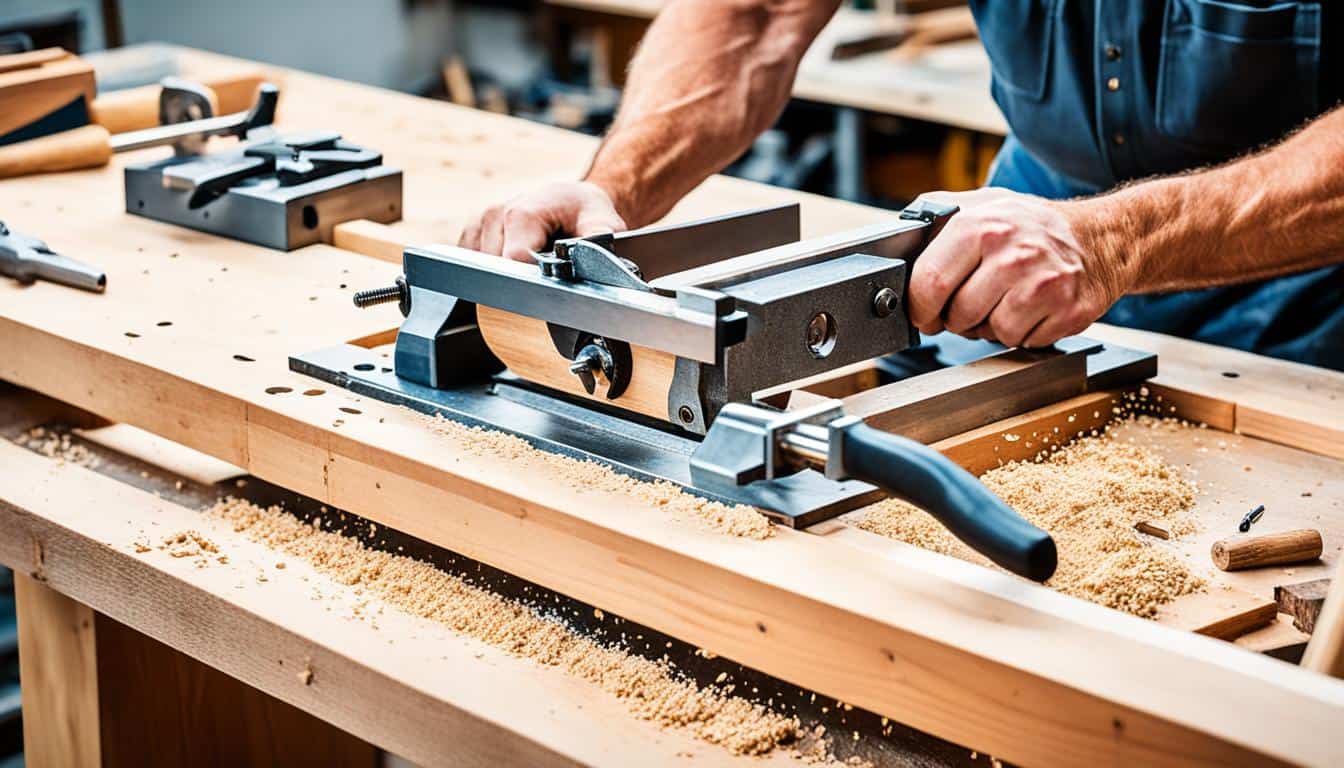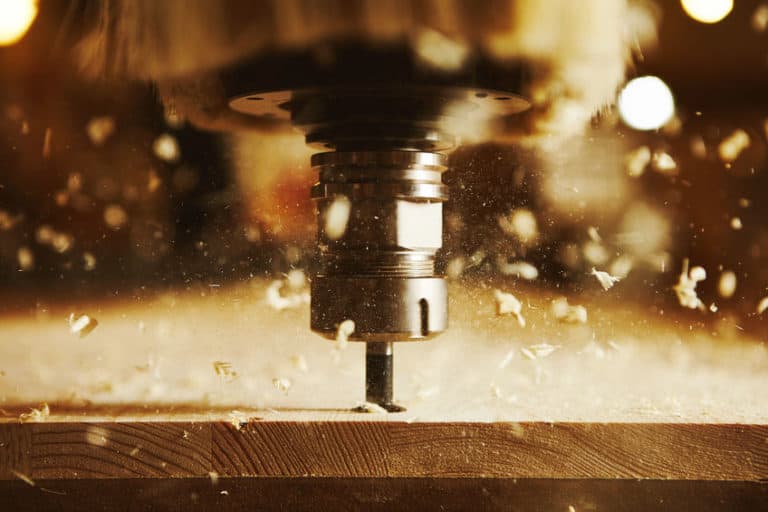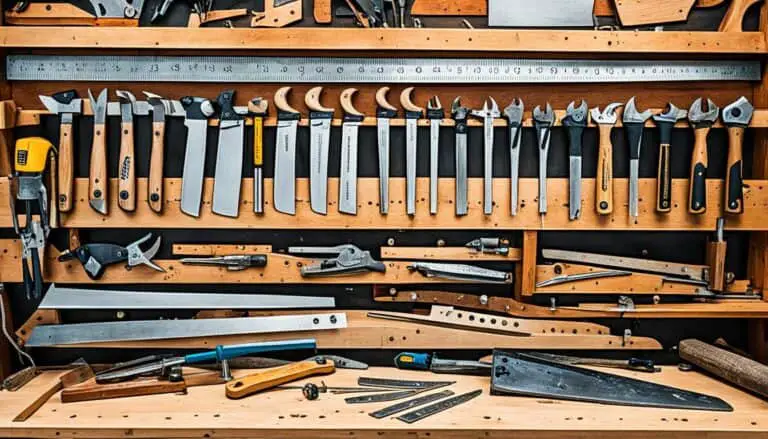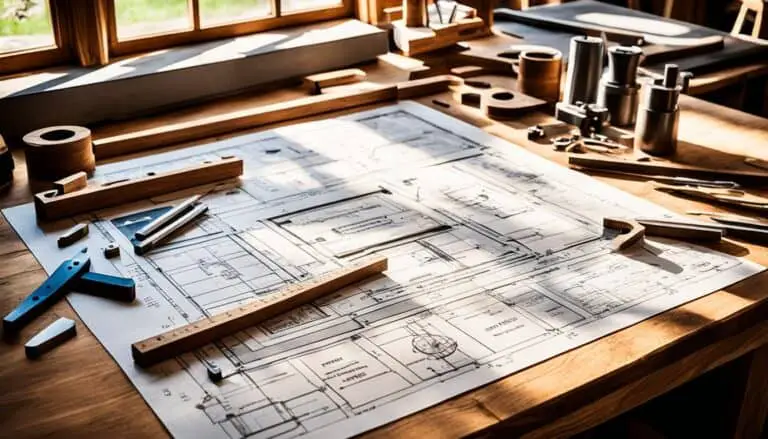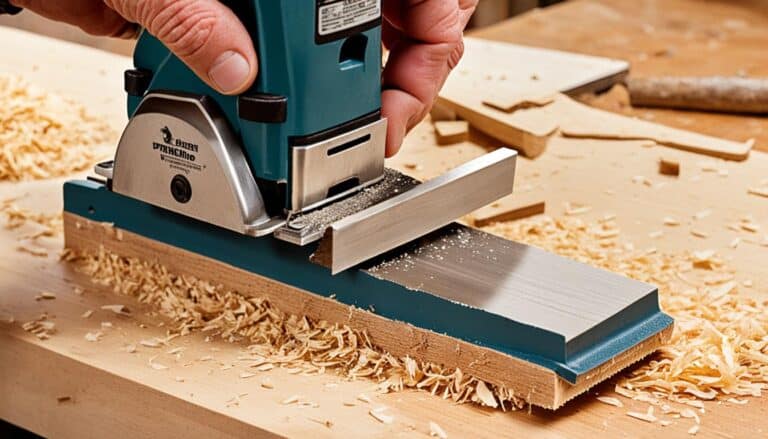A leg vice, also known as a woodworking clamp or bench vise, is a versatile and cost-effective tool that can greatly enhance your workshop. It operates on a lever system, providing high clamping power for various woodworking and metalworking projects. In this ultimate leg vice guide, we will explore the benefits, uses, and installation of this valuable workshop tool.
Key Takeaways:
- A leg vice is a versatile workshop tool that excels at clamping and securing workpieces, making it essential for woodworking and metalworking projects.
- It operates on a lever system, offering high clamping power and stability for working with different materials and sizes.
- Installing a leg vice may require accurate joinery and careful placement, but it can be achieved with proper planning and execution.
- Leg vices are cost-effective, customizable, and can hold wider boards compared to other types of vises.
- Regular maintenance and care, as well as following safety precautions, are important for optimal performance and longevity of a leg vice.
What is a Leg Vice and How Does it Work?
A leg vice, also known as a woodworking clamp, is a versatile tool designed to enhance your workshop. It operates on a lever system, providing impressive clamping power for various woodworking and metalworking projects. Featuring a simple yet effective design, a leg vice consists of a lever, typically made of wood or metal, that is inserted into a parallel guide. The parallel guide is a board positioned perpendicular to the clamping face of the leg vice, and it is attached at the bottom with a tenon.
When the vice screw is tightened, the lever presses against the leg of the workbench, generating a strong clamping force. This lever system enables the leg vice to securely grip and hold workpieces in place. Whether you are working with wood or metal, a leg vice provides the stability and clamping power needed to tackle various tasks.
One may wonder why a leg vice is such an effective tool. The answer lies in its lever action and the force it applies. The lever amplifies the applied force, allowing for greater clamping power. This ensures that your workpieces are firmly held in place, enabling you to work with precision and confidence. The leg vice’s clamping power makes it an indispensable tool for any woodworking or metalworking project, from simple DIY tasks to complex professional endeavors.
“A leg vice is a go-to tool for woodworkers and metalworkers due to its lever-based clamping system, which provides exceptional holding strength.”
Whether you need to saw, carve, drill, file, or perform any other task that requires securing your workpieces, a leg vice gives you the stability and control necessary to achieve accurate results. By understanding the mechanics and benefits of a leg vice, you can effectively utilize this tool in your workshop to enhance your woodworking and metalworking projects.
Benefits of a Leg Vice
There are several benefits to using a leg vice in your workshop. Firstly, it is a cost-effective tool, with decent screw hardware available for under $50. The clamping face, or chop, can be made from various wood species, allowing for customization and affordability. Additionally, the wide width of the chop provides incredible clamping power while remaining unobtrusive. Leg vices excel at holding boards for joinery tasks such as dovetailing or sawing tenons. They also offer stability and allow for clamping wider boards compared to other types of vises.
Installing a Leg Vice
Installing a leg vice is an important step in setting up your workshop for accurate joinery and secure clamping. To ensure proper operation, accurate joinery and precise placement are crucial. By following the right installation process, you can make the most out of your leg vice and create a reliable clamping solution for your woodworking projects.
When installing a leg vice, there are a few key components to consider: the vise chop, the leg of the workbench, and the necessary holes and mortises for holding the vise screw guide, parallel guide, and tenon in place. These components work together to provide stability and functionality to the leg vice.
For accurate joinery, it is recommended to install a leg vice during the construction of a new workbench. This allows for proper planning and execution, minimizing any challenges that may arise during retrofitting. However, with careful attention to detail, even woodworkers of varying skill levels can successfully install a leg vice on an existing workbench.
By following precise measurements and guidelines, you can ensure a seamless installation that promotes accurate joinery and reliable clamping power. Take the time to carefully align and secure all components, adhering to the manufacturer’s instructions for optimal performance.
Remember, the installation process sets the foundation for your leg vice. By investing time and effort into accurate joinery and proper placement, you can create a reliable clamping solution that enhances the efficiency and precision of your woodworking projects.
Installation Steps:
- Prepare the workbench by identifying the ideal location for the leg vice.
- Measure and mark the position for the vise chop, ensuring it is aligned with the edge of the workbench and at a comfortable height for clamping.
- Bore holes and mortises for the vise screw guide, parallel guide, and tenon, following the manufacturer’s instructions and ensuring accurate measurements.
- Assemble the leg vice components, carefully aligning and securing them in their designated positions.
- Tighten all screws and bolts, ensuring a solid and secure installation.
- Double-check the alignment and operation of the leg vice, making any necessary adjustments.
- Test the clamping power and functionality of the leg vice with various workpieces, ensuring it meets your requirements.
By following these installation steps and prioritizing accurate joinery, you can create a stable and efficient leg vice that enhances the precision of your woodworking projects. Remember to consult the manufacturer’s instructions for specific guidelines and recommendations based on the leg vice model you choose.
Versatility of a Leg Vice
A leg vice is a woodworking clamp that offers remarkable versatility in clamping boards of different widths. This makes it an essential tool for a wide range of woodworking and metalworking projects.
The key to the leg vice’s versatility lies in its adjustable parallel guide. The parallel guide holds the lever, allowing you to accommodate boards of varying thicknesses. By adjusting the parallel guide, you can ensure a secure grip on boards of different widths, providing maximum stability during your work.
While clamping boards of different widths may require repositioning the lever, it can be easily done in sequence, allowing for seamless transitions between different tasks. This adjustability allows you to work efficiently and effectively with various sizes of boards without the need for multiple clamps.
Additionally, the screw placement of the leg vice can be adjusted to suit your needs. By adjusting the position of the screws, you can clamp wider boards without any interference from the screws themselves. This feature ensures that you have unrestricted access to the entire width of the board, making the leg vice a truly versatile clamping solution.
Whether you are working on delicate woodworking projects or robust metalworking tasks, the versatility of a leg vice ensures that you have the flexibility to tackle projects of different sizes and materials. Its ability to adapt to various board widths and customizable screw placement makes it an indispensable tool in any workshop.
| Benefits of a Leg Vice | Drawbacks of a Leg Vice |
|---|---|
|
|
Drawbacks of a Leg Vice
While a leg vice offers many benefits, there are some drawbacks to consider. The installation of a leg vice can be challenging, as it requires precise boring of holes and mortises. Additionally, the parallel guide may need constant adjustment when clamping boards of different widths. However, these challenges can be overcome with careful planning and proper execution. It is important to weigh the benefits against the drawbacks to determine if a leg vice is the right choice for your workshop.
| Drawbacks of a Leg Vice | Solutions/Recommendations |
|---|---|
| The installation process can be challenging, requiring precise boring of holes and mortises. | Take your time planning and measuring before drilling holes and mortises. Use accurate measurement tools and follow detailed instructions provided by the manufacturer. |
| The parallel guide may require constant adjustment when clamping boards of different widths. | Develop a system for quick and easy adjustments based on the typical range of board widths you work with. Take note of the adjustments required for different scenarios and develop a personal guide for future clamping. |
Despite these challenges, the benefits of a leg vice, such as its high clamping power and versatility, often outweigh the drawbacks. With proper planning, installation, and adjustment techniques, a leg vice can be a valuable addition to your workshop, providing secure clamping for your woodworking projects.
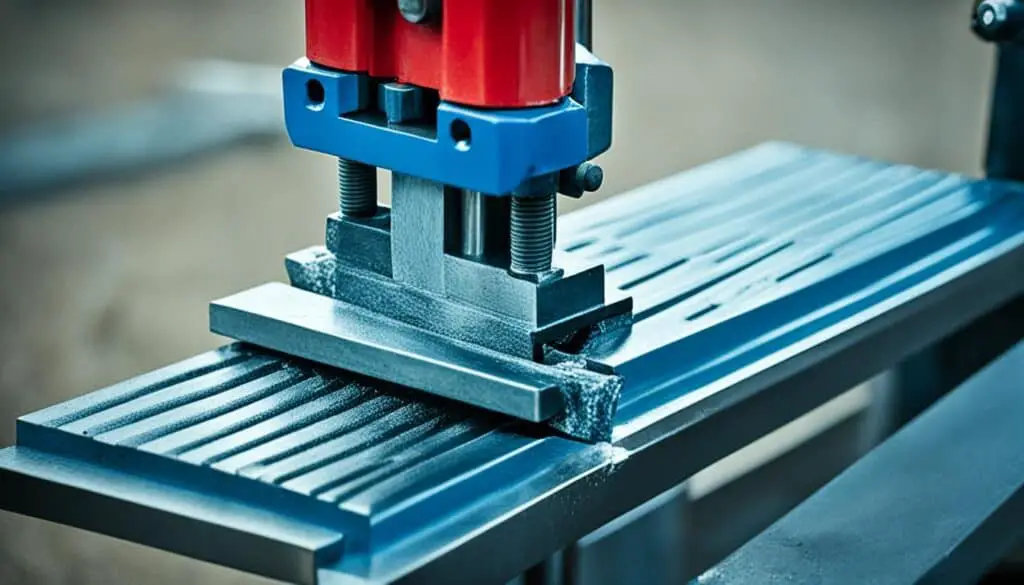
Leg Vice Alternatives
While a leg vice is a popular choice for many woodworkers, there are alternative options to consider. Face vices and wagon vices are two common alternatives that offer different features and benefits.
Face Vice
A face vice is a front-mounted vice that provides a strong grip and is suitable for a wide range of woodworking tasks. It is designed to clamp workpieces securely against the front edge of the workbench. With its robust construction, a face vice offers excellent stability and can handle heavy-duty clamping requirements.
Wagon Vice
A wagon vice is a versatile vice that can be easily moved and clamped at various positions on a workbench. It consists of a bench-mounted bracket and a sliding jaw, allowing you to position the vice wherever it is most convenient for your working needs. The sliding jaw can be locked in place, providing a strong and secure grip on the workpiece.
These alternatives may be more suitable for specific workshop needs or preferences. The choice between a leg vice, face vice, or wagon vice depends on factors such as the type of projects you work on, the level of clamping power required, and the space available in your workshop.
| Vice Type | Features | Benefits |
|---|---|---|
| Leg Vice | Clamps parallel to workbench leg using a lever system | Cost-effective, versatile, provides high clamping power |
| Face Vice | Front-mounted vice for clamping workpieces against the workbench front edge | Strong grip, stability, suitable for heavy-duty clamping |
| Wagon Vice | Vice that can be easily moved and clamped at various positions on the workbench | Versatile, adjustable, provides a secure grip on workpieces |
“The choice between a leg vice, face vice, or wagon vice depends on factors such as the type of projects you work on, the level of clamping power required, and the space available in your workshop.”
Leg Vice Maintenance and Care
To ensure the longevity and optimal performance of your leg vice, regular maintenance and care are essential. By following these maintenance practices, you can prolong the durability of your woodworking clamp and ensure its efficient functionality.
1. Clean and Lubricate the Vise Screw
Keeping the vise screw clean and properly lubricated is crucial for smooth operation. Regularly remove any debris or sawdust buildup from the screw threads using a soft brush or cloth. Apply a suitable lubricant, such as silicone spray or white lithium grease, to prevent friction and promote easy turning.
2. Check for Loose or Worn Parts
Inspect your leg vice for any loose or worn-out parts. Tighten any loose screws or bolts using the appropriate tools, ensuring a secure and stable clamping mechanism. Replace any worn parts, such as damaged wooden chops or worn-out screws, to maintain optimal performance.
3. Adjust the Parallel Guide
The parallel guide, which holds the lever in place, should be properly adjusted to accommodate different thicknesses of workpieces. Verify that the guide is aligned parallel to the clamping face and securely attached. Make any necessary adjustments to ensure a snug fit and avoid any slippage during clamping.
4. Regular Inspection and Cleaning
Regularly inspect your leg vice for any signs of wear, damage, or rust. Address these issues promptly to prevent further deterioration. Clean the clamping face, lever, and guide using a mild detergent and a soft cloth. Dry the components thoroughly to prevent rust or corrosion.
5. Store in a Clean and Dry Environment
When not in use, store your leg vice in a clean and dry environment to prevent rust and damage. Consider using a cover or protective sleeve to shield it from dust and moisture. Avoid storing it near any corrosive materials or in excessive heat or humidity, as these conditions can degrade the vice’s performance and durability.
By following these maintenance and care practices, you can ensure that your leg vice remains in excellent condition and continues to provide reliable clamping power for your woodworking projects.
Leg Vice Accessories
Enhance the functionality of your leg vice with a variety of accessories, designed to optimize your woodworking and metalworking projects. These accessories can expand the capabilities of your leg vice, providing additional support, stability, and versatility.
Bench Dogs
Bench dogs are one of the most common accessories used with a leg vice. These cylindrical devices are inserted into holes in the workbench, providing a secure and stable surface for clamping workpieces. By utilizing bench dogs, you can hold your workpieces securely in place, allowing for precise and accurate woodworking or metalworking tasks.
Holdfasts
Holdfasts are another valuable accessory that can be used with a leg vice. These clamping devices typically consist of a long metal rod with a curved end that can be inserted into holes on the workbench surface. With a simple tap of a mallet, the holdfast is secured, providing a strong and reliable grip for a wide range of clamping applications. Holdfasts are particularly useful when working with irregularly shaped or non-standard workpieces.
Specialized Jaws
To accommodate specific woodworking or metalworking tasks, specialized jaws can be attached to your leg vice. These jaws are designed to hold specific types of materials or shapes, providing a secure grip and preventing slippage during clamping. Examples of specialized jaws include pipe jaws for holding cylindrical objects, V-shaped jaws for securing round or angled workpieces, or soft jaws for delicate or easily damaged materials.
By utilizing these accessories, you can maximize the functionality and versatility of your leg vice, enabling you to tackle a wider range of projects with ease and precision.
Leg Vice Tips and Tricks
To make the most out of a leg vice, there are several tips and tricks that can help improve its efficiency and effectiveness.
1. Use Wooden or Non-Marring Jaw Pads
One tip is to use wooden or non-marring jaw pads to protect delicate workpieces from damage. By attaching these pads to the clamping face, you can prevent scratches or dents on your projects while still ensuring a secure grip.
2. Optimal Screw Placement
Another trick is to position the vise screw slightly below the workbench surface. This allows for clamping of thicker materials, as the screw won’t obstruct the workspace. It provides more flexibility and adaptability when working with larger or uneven surfaces.
3. Utilize the Full Clamping Face
Utilizing the full length of the clamping face is essential for efficient use of the leg vice. By distributing the clamping force evenly across the entire face, you can achieve a more secure grip on your workpieces. This is especially beneficial when working with longer or wider materials.
4. Adjust the Parallel Guide
Adjusting the parallel guide as needed can optimize the clamping power and stability of the leg vice. If you are working with different widths of boards, ensure that the parallel guide is properly adjusted to accommodate the specific thickness. This will provide consistent and reliable clamping pressure, enhancing the overall performance of the leg vice.
By implementing these tips and tricks, you can enhance the efficiency and effectiveness of your leg vice, making it a valuable asset in your woodworking or metalworking projects.
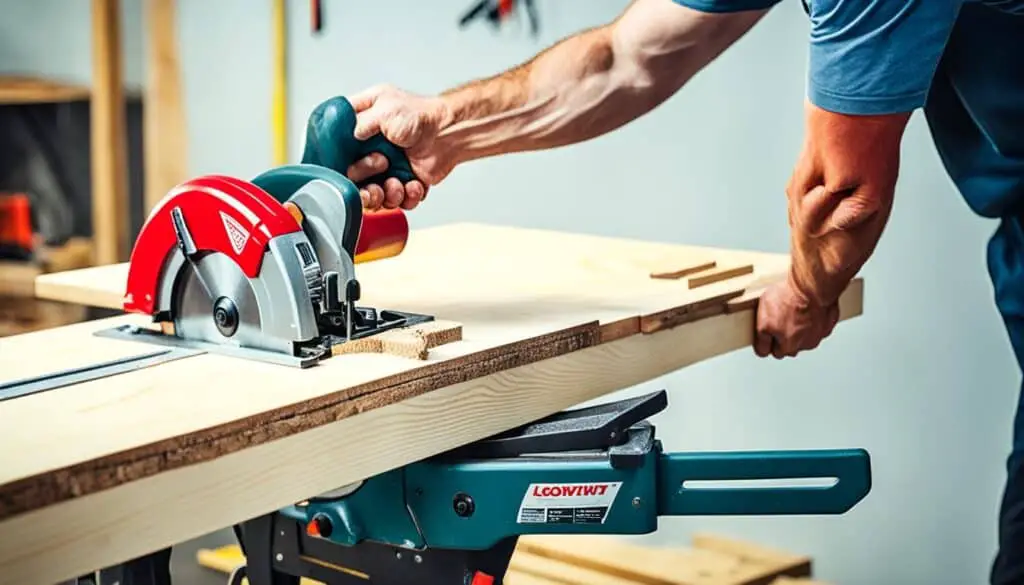
| Tips and Tricks | Description |
|---|---|
| Use Jaw Pads | Protect delicate workpieces from damage by using wooden or non-marring jaw pads. |
| Optimal Screw Placement | Position the vise screw slightly below the workbench surface to allow clamping of thicker materials. |
| Utilize Full Clamping Face | Make use of the entire clamping face to distribute the clamping force evenly. |
| Adjust Parallel Guide | Ensure the parallel guide is properly adjusted to accommodate different board widths. |
Leg Vice Safety Precautions
When using a leg vice, it is important to prioritize safety. Here are some essential safety precautions to keep in mind:
- Wear Personal Protective Equipment (PPE)
Always wear appropriate personal protective equipment, such as safety glasses and gloves. This will help protect yourself from potential hazards while using the leg vice.
- Securely Anchor the Workbench and Leg Vice
Ensure that both the workbench and leg vice are securely anchored to prevent any movement or accidents during clamping. This will provide stability and minimize the risk of accidents.
- Regularly Inspect for Wear or Damage
Regularly inspect the leg vice for any signs of wear, such as loose or damaged parts. If any issues are found, address them immediately to maintain the safety and functionality of the leg vice.
Safety should always be a top priority when working with woodworking clamps. Taking simple precautions can go a long way in preventing injuries and accidents.
By following these safety precautions, you can minimize the risk of injuries and accidents while using a leg vice. Remember to always prioritize safety in your workshop.
Leg Vice Safety Precautions Checklist
| Safety Precautions | Actions to Take |
|---|---|
| Wear Personal Protective Equipment (PPE) | Use safety glasses and gloves |
| Securely Anchor the Workbench and Leg Vice | Ensure proper installation and stability |
| Regularly Inspect for Wear or Damage | Check for loose or damaged parts and address them promptly |
Leg Vice Case Studies
Real-life case studies offer valuable insights into the practical applications and benefits of a leg vice. By exploring how woodworkers and metalworkers have utilized leg vices in their projects, you can gain inspiration and ideas for incorporating this versatile tool into your own workshop.
Case studies highlight the unique features and capabilities of leg vices, showcasing their effectiveness in various real-life applications. Whether it’s clamping materials for precise joinery, securing workpieces during intricate detailing, or supporting heavy-duty metalworking tasks, leg vices have proven their value in a wide range of scenarios.
Woodworker Jane Thompson found that using a leg vice significantly improved the accuracy of her dovetailing. The sturdy clamping power and stable grip provided by the leg vice allowed her to work with confidence, resulting in tighter and more precise joints.
Metalworker Mark Rodriguez relied on a leg vice to hold large, heavy pieces of metal securely while he performed intricate shaping and forming. The leg vice’s high clamping power and stability ensured that the workpieces remained in place even under intense pressure, enabling Mark to execute his metalworking projects with exceptional precision.
These case studies demonstrate the invaluable role leg vices play in real-life woodworking and metalworking scenarios. They illustrate the versatility, reliability, and enhanced workflow that leg vices can bring to your projects.
Benefits of Studying Leg Vice Case Studies
By studying leg vice case studies, you can:
- Discover innovative techniques and approaches used by experienced woodworkers and metalworkers
- Obtain practical insights on how to optimize the performance of a leg vice
- Gain a deeper understanding of the potential applications and benefits of a leg vice in your own workshop
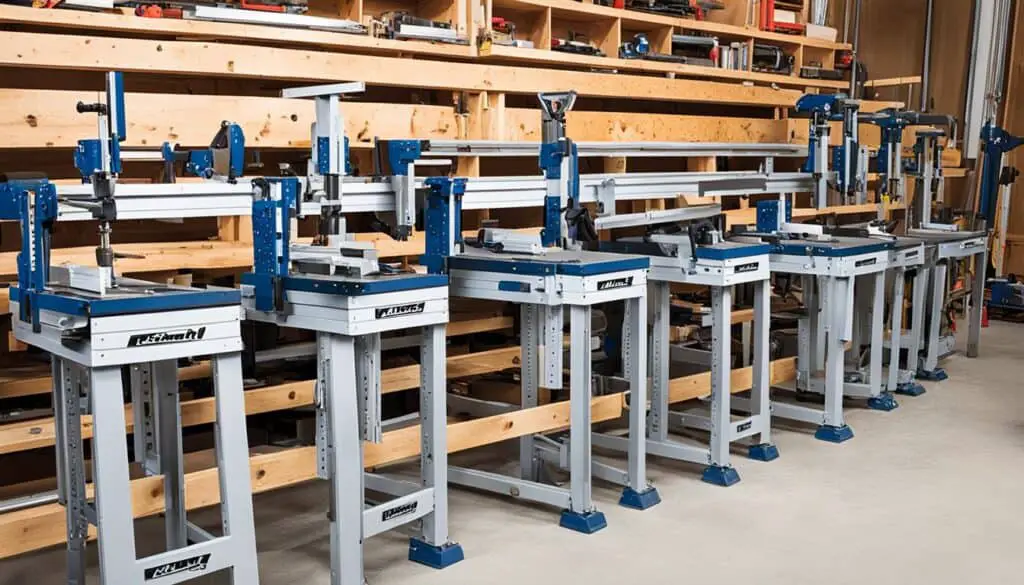
The visual image above showcases how real-life case studies can provide valuable insights into successful leg vice applications.
Leg Vice Maintenance and Troubleshooting
Like any tool, a leg vice may require occasional maintenance and troubleshooting to address common issues that may arise. By following proper maintenance practices, you can keep your leg vice in optimal working condition and ensure its longevity. Additionally, troubleshooting common problems can help you resolve issues quickly and efficiently. Here are some maintenance and troubleshooting tips for your leg vice:
Maintenance
Maintaining your leg vice is essential for its smooth operation and durability. Regular maintenance tasks include:
- Cleaning: Remove dust, debris, and any built-up residue from the vise screw, parallel guide, and other components. You can use a brush or a cloth to clean these parts.
- Lubrication: Apply an appropriate lubricant, such as silicone spray or machine oil, to the vise screw to ensure smooth movement. Lubricate other moving parts as needed.
- Inspection: Regularly inspect the leg vice for any loose or worn parts. Tighten any loose screws or bolts and replace any damaged or worn-out components.
By performing these maintenance tasks regularly, you can prevent potential issues and keep your leg vice operating at its best.
Troubleshooting Common Issues
If you encounter any issues with your leg vice, here are some common problems and their possible solutions:
“The leg vice is not clamping properly.”
This issue may occur due to a misaligned parallel guide or loose vise screw. Start by checking the alignment of the parallel guide and adjusting it if necessary. Ensure that the vise screw is tightened securely to provide sufficient clamping force.
“The vise screw is difficult to turn.”
If the vise screw becomes hard to turn, it may be due to debris or lack of lubrication. Clean the vise screw thoroughly and apply lubricant to ensure smooth operation. If the issue persists, inspect the screw for any damage or wear and consider replacing it if necessary.
“The leg vice is wobbling or unstable.”
A wobbling or unstable leg vice is often caused by loose or misaligned components. Check all screws, bolts, and connections to ensure they are properly tightened. Adjust and align the parallel guide and other components to ensure stability and smooth operation.
If you encounter any specific problems or challenges with your leg vice, consult the manufacturer’s instructions or seek advice from experienced woodworkers or metalworkers. They can provide insights and guidance to help you address any issues effectively.
Remember, addressing maintenance and troubleshooting tasks promptly can help you keep your leg vice in optimal working condition, ensuring its reliability for future woodworking and metalworking projects.
Leg Vice for Woodworking and Metalworking
A leg vice is a versatile tool that can be used for both woodworking and metalworking projects. It provides a secure clamping mechanism for holding workpieces in place during various tasks, such as sawing, drilling, chiseling, or filing. With its high clamping power and stability, a leg vice is an essential tool for any workshop, whether you are working with wood or metal. By choosing the right leg vice for your specific needs and properly maintaining it, you can enhance the efficiency and precision of your woodworking and metalworking projects.
When working with wood, a leg vice holds the material securely, allowing you to make precise cuts and fine-tune your craftsmanship. Whether you are sawing a piece of lumber or carving intricate details, the leg vice provides the stability and grip needed for accurate work. It also eliminates the need for additional clamps, ensuring a clutter-free workspace.
For metalworking, a leg vice offers a reliable clamping solution that keeps your workpiece steady while you perform various metal shaping and fabrication tasks. Whether you are bending, shaping, or welding metal, the leg vice holds the material securely, allowing you to work with precision and confidence.
One of the key advantages of a leg vice is its versatility. It can accommodate a wide range of workpiece sizes and shapes, making it suitable for both small-scale and large-scale projects. The adjustable jaws allow you to grip different materials securely, ensuring that they stay in place throughout your work.
A leg vice is also designed to withstand heavy-duty use. Its robust construction and durable materials ensure that it can handle the demands of woodworking and metalworking tasks. Whether you are a professional craftsman or a hobbyist, investing in a high-quality leg vice will provide you with a reliable tool that will last for years.
Proper maintenance is essential to keep your leg vice in optimal working condition. Regularly clean and lubricate the moving parts to prevent rust and ensure smooth operation. Check the alignment of the jaws and adjust as needed to maintain a tight grip on your workpiece. By taking care of your leg vice, you can extend its lifespan and enjoy consistent performance.
In summary, a leg vice is a versatile and indispensable tool for woodworking and metalworking projects. It provides secure clamping, stability, and versatility, making it an essential component of any workshop. By choosing the right leg vice for your needs and maintaining it properly, you can enhance the efficiency and precision of your woodworking and metalworking tasks, ensuring successful outcomes for your projects.
Leg Vice Brands and Models
When looking to purchase a leg vice, you’ll find a wide range of brands and models to choose from. Some of the popular brands in the market include Record, Irwin, and Veritas, among others. Each brand offers its unique features, sizes, and price ranges, making it important to consider your specific needs and budget when selecting a leg vice.
Reading customer reviews can provide valuable insights into the performance and durability of different leg vice models. Additionally, consulting woodworking or metalworking forums can give you recommendations from experienced users, helping you make an informed decision.
When comparing leg vice brands and models, consider factors such as clamping power, ease of use, construction quality, and overall functionality. Look for a leg vice that aligns with the type of projects you typically work on and offers the features that will benefit your specific workshop needs.
Remember, investing in a high-quality leg vice is essential for a smooth and efficient woodworking or metalworking experience. Take your time to research and evaluate different brands and models before making your final buying decision.
Conclusion
In conclusion, a leg vice is a valuable tool that can greatly enhance your workshop. Its simplicity, versatility, and cost-effectiveness make it a popular choice for woodworkers and metalworkers alike. By understanding the benefits, uses, and installation process of a leg vice, you can make an informed decision on whether it is the right tool for your specific needs.
Whether you are constructing a new workbench or retrofitting an existing one, a leg vice can provide the clamping power and stability required for a wide range of projects. Its ability to securely hold workpieces in place during sawing, drilling, chiseling, or filing tasks makes it an essential tool for any woodworking or metalworking project.
Investing in a leg vice will unlock the potential of your workshop, allowing you to achieve top-notch woodworking and metalworking clamping. With its reliable performance, easy installation, and versatile capabilities, a leg vice is a must-have tool for any craftsman or DIY enthusiast.
FAQ
What is a leg vice and how does it work?
A leg vice, also known as a woodworking clamp or bench vise, is a versatile tool that operates on a lever system to provide high clamping power for various woodworking and metalworking projects.
What are the benefits of a leg vice?
A leg vice is a cost-effective tool that offers excellent clamping power, stability, and the ability to hold wider boards compared to other types of vises. It is ideal for joinery tasks and customizable with a wide choice of wood species for the clamping face.
How do I install a leg vice?
Installing a leg vice requires accurate joinery and proper placement of the vise screw guide, parallel guide, and tenon. It is recommended to install a leg vice during the construction of a new workbench.
How versatile is a leg vice in clamping different widths?
The parallel guide of a leg vice can be adjusted to accommodate boards of varying thicknesses. While clamping boards of different widths may require repositioning the lever, it can be easily done in sequence.
What are the drawbacks of a leg vice?
The installation of a leg vice can be challenging, and the parallel guide may require constant adjustment when clamping boards of different widths. However, these challenges can be overcome with proper planning and execution.
What are the alternatives to a leg vice?
Face vices and wagon vices are popular alternatives that offer different features and benefits for specific workshop needs or preferences.
How do I maintain and care for a leg vice?
Regular maintenance and care include keeping the vise screw clean and lubricated, checking for loose or worn parts, and ensuring the parallel guide is properly adjusted. Storing the leg vice in a clean and dry environment is also recommended to prevent rust and damage.
What accessories are available for a leg vice?
Accessories such as bench dogs, holdfasts, and specialized jaws can enhance the functionality of a leg vice for specific woodworking or metalworking tasks.
What tips and tricks can improve the efficiency of a leg vice?
Using wooden or non-marring jaw pads, positioning the vise screw slightly below the workbench surface, and utilizing the full length of the clamping face can optimize the clamping power and stability of a leg vice.
What safety precautions should I take when using a leg vice?
Always wear appropriate personal protective equipment, securely anchor the workbench and leg vice, and regularly inspect the leg vice for any signs of wear or damage to minimize the risk of injuries and accidents.
Are there any real-life case studies showcasing the practical applications of a leg vice?
Yes, real-life case studies can provide valuable insights and inspiration on how to incorporate a leg vice into woodworking and metalworking projects.
How do I troubleshoot common issues with a leg vice?
Regular cleaning and lubrication of the vise screw, adjusting the parallel guide, and tightening any loose parts can address common maintenance issues with a leg vice. Consult the manufacturer’s instructions or seek advice from experienced woodworkers or metalworkers for specific problems.
Can a leg vice be used for both woodworking and metalworking projects?
Yes, a leg vice is a versatile tool suitable for both woodworking and metalworking projects, providing a secure clamping mechanism for various tasks such as sawing, drilling, chiseling, or filing.
What are some reputable leg vice brands and models to consider?
Popular leg vice brands include Record, Irwin, and Veritas, among others. Each brand offers different features, sizes, and price ranges, so it is important to consider your specific needs and budget when selecting a leg vice.

